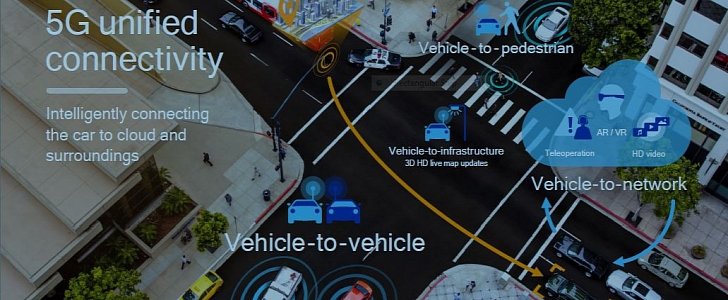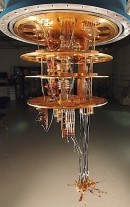Last month, at the In&Out Digital Mobility event in Rennes, French auto group PSA and mobile technologies specialist Qualcomm presented the Cellular Vehicle-to-Everything technology (C-V2X). Still some years away from real-life implementation, this technology would allow future humans and vehicles to interact in ways never dreamed possible on public roads.
Imagine a world populated with autonomous cars, electric or otherwise, capable of transmitting their position to each other. A world where street lights and street signs alert the car of their presence, status and meaning. A world where pedestrians would be alerted by both road infrastructure and vehicles of possible dangers and changing travel situations.
In short, Qualcomm plans to be one of the first companies to offer integrated solutions for full-connected cars. That means making them capable of talking to the 5G network that powers them, to the road infrastructure, to other vehicles and to pedestrians alike.
5G is essential for Level 5 automated cars (AV), as it can lead to more precise positioning and faster update times for the information received and transmitted. For AVs to operate effectively, the targeted positioning through this tech if of under 1 meters (3.2 feet).
The C-V2X will also make use of other exiting technologies for better communicating. It will use radar for weather updates and long range scans. Cameras would be used to interpret object and signs. LIDAR would be used for medium range scans and depth perception, while ultrasonic waves would be used for short range scans.
C-V2X will feature several unique technologies, specifically designed to increase its accuracy. A V2X wireless sensor will be able to provide 360 degrees non-line of sight sensing for the vehicles. Sub-meter positioning accuracy will be provided by the use of HD mapping with live updates.
One of the most interesting features of the system is that it does not require a SIM card to work. It uses instead Qualcomm’s Wi-Fi based Dedicated Short-Range Communications system.
Using all the hardware described above, C-V2X-equipped cars will be able to relay to each other much more information than before. For instance, when two cars travel in the same direction, the one in front will be capable of telling the one behind whether it is safe to pass or not.
Information about road works, local hazards or blind curves could also be relayed from car to car. At blind intersections, a car approaching it would be capable of warning the other that it is approaching the intersection. Also, if one car sees a pedestrian engaging in dangerous behavior, like crossing the street at the blind intersection, it could tell other vehicles in the vicinity to look out.
The first commercial solution for carmakers based on the C-V2X is expected to be rolled out in the second half of 2018. Several auto groups have expressed interest in using the new technology, including the aforementioned PSA, but also Audi, Ford, and SAIC.
More details about what C-V2X can do can be found at the following link or in the attched PDF.
In short, Qualcomm plans to be one of the first companies to offer integrated solutions for full-connected cars. That means making them capable of talking to the 5G network that powers them, to the road infrastructure, to other vehicles and to pedestrians alike.
COMPONENTS
The Qualcomm technology is highly dependent on the soon-to-be implemented 5G network. Samsung, Intel, Qualcomm, Nokia, Huawei and Ericsson are just a few of the companies now racing to develop the required hardware for the integration of the next generation mobile internet protocols.5G is essential for Level 5 automated cars (AV), as it can lead to more precise positioning and faster update times for the information received and transmitted. For AVs to operate effectively, the targeted positioning through this tech if of under 1 meters (3.2 feet).
The C-V2X will also make use of other exiting technologies for better communicating. It will use radar for weather updates and long range scans. Cameras would be used to interpret object and signs. LIDAR would be used for medium range scans and depth perception, while ultrasonic waves would be used for short range scans.
C-V2X will feature several unique technologies, specifically designed to increase its accuracy. A V2X wireless sensor will be able to provide 360 degrees non-line of sight sensing for the vehicles. Sub-meter positioning accuracy will be provided by the use of HD mapping with live updates.
One of the most interesting features of the system is that it does not require a SIM card to work. It uses instead Qualcomm’s Wi-Fi based Dedicated Short-Range Communications system.
CAR-TO-CAR COMMUNICATION (V2V)
Car-to-car communication is currently under development in the labs of several automakers. Qualcomm however plans to take things to a whole new level.Using all the hardware described above, C-V2X-equipped cars will be able to relay to each other much more information than before. For instance, when two cars travel in the same direction, the one in front will be capable of telling the one behind whether it is safe to pass or not.
Information about road works, local hazards or blind curves could also be relayed from car to car. At blind intersections, a car approaching it would be capable of warning the other that it is approaching the intersection. Also, if one car sees a pedestrian engaging in dangerous behavior, like crossing the street at the blind intersection, it could tell other vehicles in the vicinity to look out.
CAR-TO-PEDESTRIAN COMMUNICATION (V2P)
In theory, cars equipped with C-V2X can communicate their intentions to pedestrians as well. After analyzing inputs like turn signals, braking or accelerating, the system can determine what the car is about to do and then inform pedestrians in the area about key aspects of the car’s movement.The first commercial solution for carmakers based on the C-V2X is expected to be rolled out in the second half of 2018. Several auto groups have expressed interest in using the new technology, including the aforementioned PSA, but also Audi, Ford, and SAIC.
More details about what C-V2X can do can be found at the following link or in the attched PDF.



